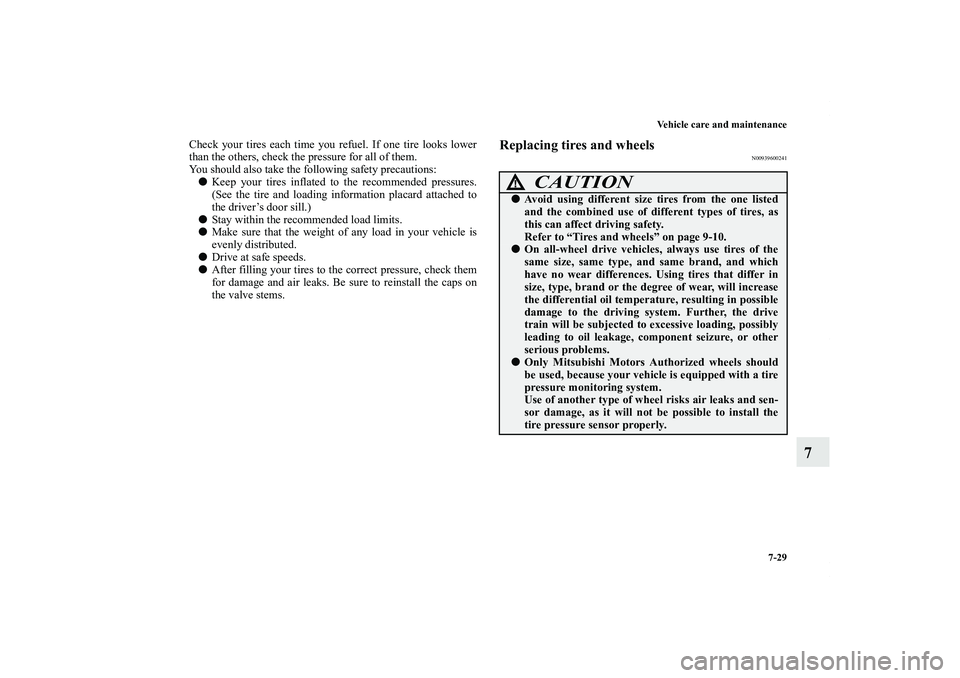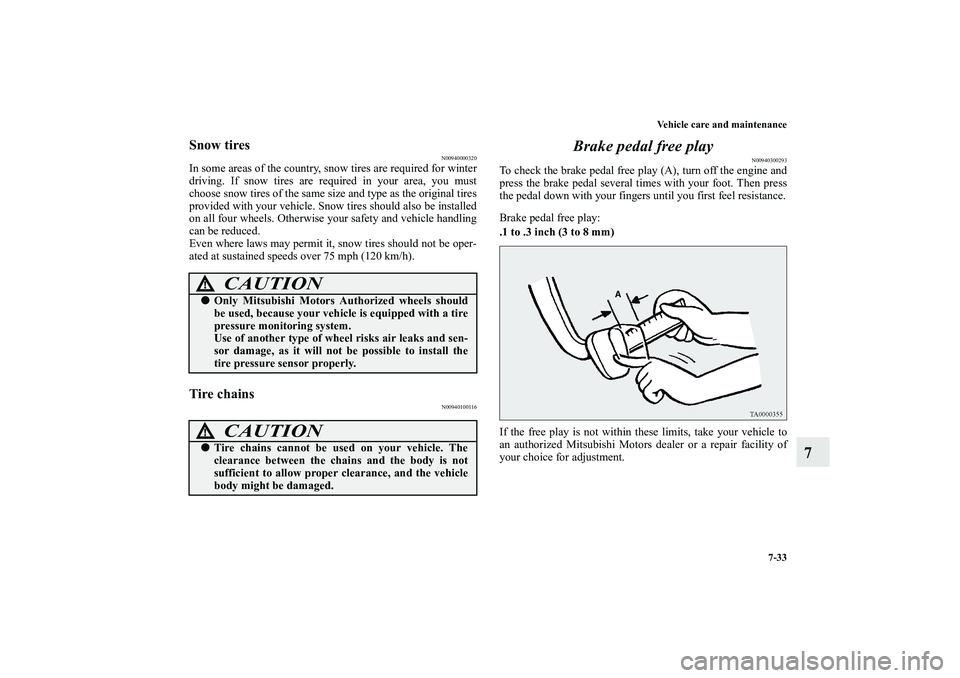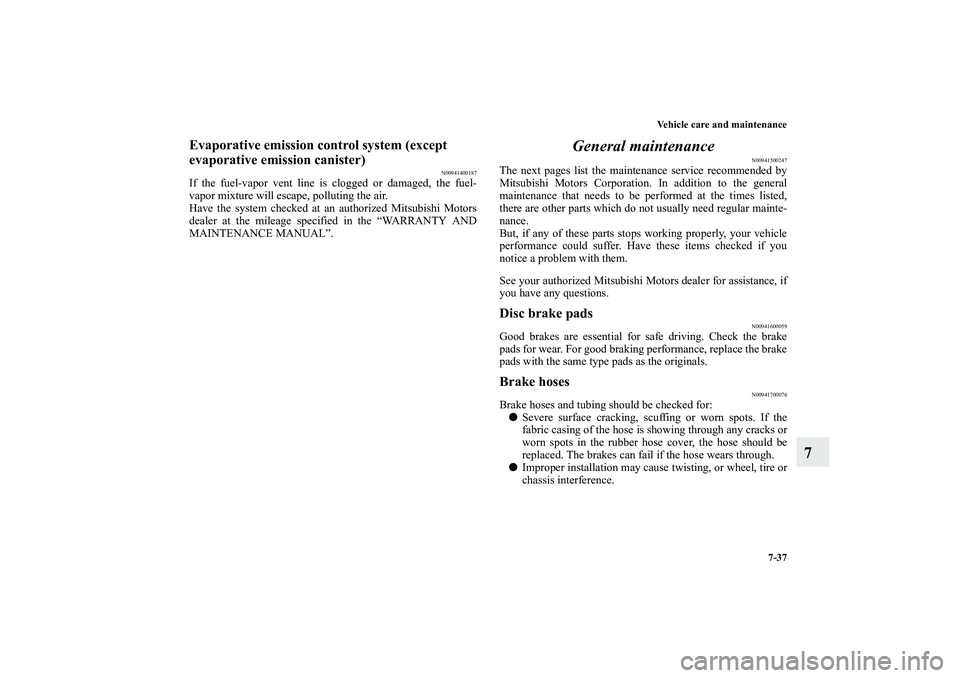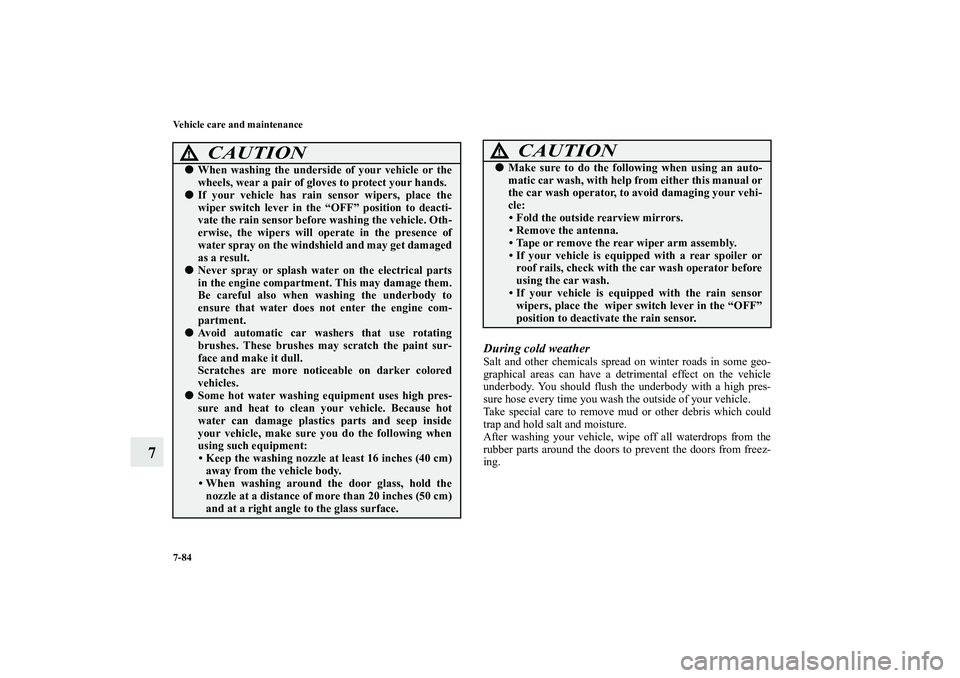Page 626 of 714

Vehicle care and maintenance
7-29
7
Check your tires each time you refuel. If one tire looks lower
than the others, check the pressure for all of them.
You should also take the following safety precautions:
�Keep your tires inflated to the recommended pressures.
(See the tire and loading information placard attached to
the driver’s door sill.)
�Stay within the recommended load limits.
�Make sure that the weight of any load in your vehicle is
evenly distributed.
�Drive at safe speeds.
�After filling your tires to the correct pressure, check them
for damage and air leaks. Be sure to reinstall the caps on
the valve stems.
Replacing tires and wheels
N00939600241
CAUTION
!�Avoid using different size tires from the one listed
and the combined use of different types of tires, as
this can affect driving safety.
Refer to “Tires and wheels” on page 9-10.�On all-wheel drive vehicles, always use tires of the
same size, same type, and same brand, and which
have no wear differences. Using tires that differ in
size, type, brand or the degree of wear, will increase
the differential oil temperature, resulting in possible
damage to the driving system. Further, the drive
train will be subjected to excessive loading, possibly
leading to oil leakage, component seizure, or other
serious problems.�Only Mitsubishi Motors Authorized wheels should
be used, because your vehicle is equipped with a tire
pressure monitoring system.
Use of another type of wheel risks air leaks and sen-
sor damage, as it will not be possible to install the
tire pressure sensor properly.
BK0122500US.book 29 ページ 2010年5月12日 水曜日 午前11時11分
Page 627 of 714

7-30 Vehicle care and maintenance
7
Tire maintenance
N00939700141
The following maintenance steps are recommended:
�Check tire pressures regularly.
�Have regular maintenance done on the wheel balance and
front and rear suspension alignment.
�Rotate your tires regularly as described in the “Tire rota-
tion” section on page 7-31.
Tread wear indicator
N00939800184
Tread wear indicators are built into the original equipment tires
on your vehicle to help you know when your tires should be
replaced. Many states have laws requiring that you replace
your tires at this point.
These indicators are molded into the bottom of the tread
grooves and will appear when the tire tread is worn down to
1/16 inch (1.6 mm).
When the bands appear next to one another in two or more
places, replace your tires.NOTE�Tire wear indicators can have different marks and loca-
tions depending on the tire manufacturer.1- Location of the tread wear indicator
2- Tread wear indicator
BK0122500US.book 30 ページ 2010年5月12日 水曜日 午前11時11分
Page 628 of 714

Vehicle care and maintenance
7-31
7
Tire rotation
N00939900488
To even out the wear on your tires and make them last longer,
Mitsubishi Motors Corporation recommends that you rotate
your tires at the mileage listed in the “WARRANTY AND
MAINTENANCE MANUAL”.
However, the timing for tire rotation may vary according to
your vehicle condition, road surface conditions, and your own
personal driving habits. Any time you notice unusual wear,
rotate your tires as soon as possible.
When rotating tires, check for uneven wear, damage, and wheel
alignment. Abnormal wear is usually caused by a wrong tire
pressure, wheels that are not aligned properly, wheels that are
out-of-balance, or severe braking.
Check with an authorized Mitsubishi Motors dealer or a repair
facility of your choice to find out the reason for uneven tread
wear.
The first tire rotation is the most important one. It will allow all
your tires to wear evenly.
CAUTION
!�A compact spare tire can be installed temporarily in
place of a tire that has been removed during the tire
rotation. However, it must not be included in the
regular tire rotation sequence.Tires that do not have arrows showing rotation direction
Tires that have arrows showing rotation directionFront
Front
BK0122500US.book 31 ページ 2010年5月12日 水曜日 午前11時11分
Page 629 of 714
7-32 Vehicle care and maintenance
7
CAUTION
!�If the tires have arrows (A) indicating the correct
direction of rotation, swap the front and rear tires
on the left-hand side of the vehicle and the front and
rear tires on the right-hand side of the vehicle sepa-
rately. Keep each tire on its original side of the vehi-
cle. When installing the tires, make sure the arrows
point in the direction in which the wheels will turn
when the vehicle moves forward. Any tire whose
arrow points in the wrong direction will not perform
to its full potential.
Front
CAUTION
!�Avoid the combined use of different types of tires.
Using different types of tires can affect vehicle per-
formance and safety.
BK0122500US.book 32 ページ 2010年5月12日 水曜日 午前11時11分
Page 630 of 714

Vehicle care and maintenance
7-33
7
Snow tires
N00940000320
In some areas of the country, snow tires are required for winter
driving. If snow tires are required in your area, you must
choose snow tires of the same size and type as the original tires
provided with your vehicle. Snow tires should also be installed
on all four wheels. Otherwise your safety and vehicle handling
can be reduced.
Even where laws may permit it, snow tires should not be oper-
ated at sustained speeds over 75 mph (120 km/h).Tire chains
N00940100116
Brake pedal free play
N00940300293
To check the brake pedal free play (A), turn off the engine and
press the brake pedal several times with your foot. Then press
the pedal down with your fingers until you first feel resistance.
Brake pedal free play:
.1 to .3 inch (3 to 8 mm)
If the free play is not within these limits, take your vehicle to
an authorized Mitsubishi Motors dealer or a repair facility of
your choice for adjustment.
CAUTION
!�Only Mitsubishi Motors Authorized wheels should
be used, because your vehicle is equipped with a tire
pressure monitoring system.
Use of another type of wheel risks air leaks and sen-
sor damage, as it will not be possible to install the
tire pressure sensor properly.
CAUTION
!�Tire chains cannot be used on your vehicle. The
clearance between the chains and the body is not
sufficient to allow proper clearance, and the vehicle
body might be damaged.
BK0122500US.book 33 ページ 2010年5月12日 水曜日 午前11時11分
Page 634 of 714

Vehicle care and maintenance
7-37
7
Evaporative emission control system (except
evaporative emission canister)
N00941400187
If the fuel-vapor vent line is clogged or damaged, the fuel-
vapor mixture will escape, polluting the air.
Have the system checked at an authorized Mitsubishi Motors
dealer at the mileage specified in the “WARRANTY AND
MAINTENANCE MANUAL”.
General maintenance
N00941500247
The next pages list the maintenance service recommended by
Mitsubishi Motors Corporation. In addition to the general
maintenance that needs to be performed at the times listed,
there are other parts which do not usually need regular mainte-
nance.
But, if any of these parts stops working properly, your vehicle
performance could suffer. Have these items checked if you
notice a problem with them.
See your authorized Mitsubishi Motors dealer for assistance, if
you have any questions.Disc brake pads
N00941600059
Good brakes are essential for safe driving. Check the brake
pads for wear. For good braking performance, replace the brake
pads with the same type pads as the originals.Brake hoses
N00941700076
Brake hoses and tubing should be checked for:
�Severe surface cracking, scuffing or worn spots. If the
fabric casing of the hose is showing through any cracks or
worn spots in the rubber hose cover, the hose should be
replaced. The brakes can fail if the hose wears through.
�Improper installation may cause twisting, or wheel, tire or
chassis interference.
BK0122500US.book 37 ページ 2010年5月12日 水曜日 午前11時11分
Page 642 of 714
Vehicle care and maintenance
7-45
7
Passenger compartment fuse location tablePassenger compartment fuse location
Sub fuse block Main fuse block
No.
Symbol
Electrical system
Capacity
1 Heater 30 A*
2Stop lights
(Brake lights)15 A
3 Rear fog light 10 A
4 Windshield wiper 30 A
5 Optional 10 A
6Door locks20 A
7Radio15 A
8 Control unit relay 7.5 A
9Interior lights
(Dome lights)15 A
10 Hazard warning flasher 15 A
11 Rear window wiper 15 A
12 Gauges 7.5 A
13Cigarette lighter
/Accessory socket15 A
14Ignition
Switch10 A
15 Sunroof 20 A
16 Outside rearview mirrors 10 A
17 All-wheel drive system 10 A
BK0122500US.book 45 ページ 2010年5月12日 水曜日 午前11時11分
Page 681 of 714

7-84 Vehicle care and maintenance
7
During cold weatherSalt and other chemicals spread on winter roads in some geo-
graphical areas can have a detrimental effect on the vehicle
underbody. You should flush the underbody with a high pres-
sure hose every time you wash the outside of your vehicle.
Take special care to remove mud or other debris which could
trap and hold salt and moisture.
After washing your vehicle, wipe off all waterdrops from the
rubber parts around the doors to prevent the doors from freez-
ing.
CAUTION
!�When washing the underside of your vehicle or the
wheels, wear a pair of gloves to protect your hands.�If your vehicle has rain sensor wipers, place the
wiper switch lever in the “OFF” position to deacti-
vate the rain sensor before washing the vehicle. Oth-
erwise, the wipers will operate in the presence of
water spray on the windshield and may get damaged
as a result.�Never spray or splash water on the electrical parts
in the engine compartment. This may damage them.
Be careful also when washing the underbody to
ensure that water does not enter the engine com-
partment.�Avoid automatic car washers that use rotating
brushes. These brushes may scratch the paint sur-
face and make it dull.
Scratches are more noticeable on darker colored
vehicles.�Some hot water washing equipment uses high pres-
sure and heat to clean your vehicle. Because hot
water can damage plastics parts and seep inside
your vehicle, make sure you do the following when
using such equipment:
• Keep the washing nozzle at least 16 inches (40 cm)
away from the vehicle body.
• When washing around the door glass, hold the
nozzle at a distance of more than 20 inches (50 cm)
and at a right angle to the glass surface.
�Make sure to do the following when using an auto-
matic car wash, with help from either this manual or
the car wash operator, to avoid damaging your vehi-
cle:
• Fold the outside rearview mirrors.
• Remove the antenna.
• Tape or remove the rear wiper arm assembly.
• If your vehicle is equipped with a rear spoiler or
roof rails, check with the car wash operator before
using the car wash.
• If your vehicle is equipped with the rain sensor
wipers, place the wiper switch lever in the “OFF”
position to deactivate the rain sensor.CAUTION
!
BK0122500US.book 84 ページ 2010年5月12日 水曜日 午前11時11分